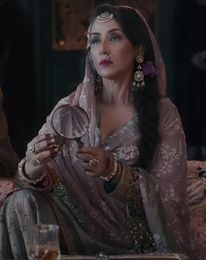Who else but Sanjay Leela Bhansali could bring on a wardrobe reset like the one in his just-dropped period piece—an eight-part Netflix series called Heeramandi? The show of the moment is set in Heera Mandi or the Diamond Bazaar—the famous brothel district in pre-Independence Lahore. In the backdrop of the beautiful nautch girls, their cultural savoir faire and their fawning sahebs, is India’s freedom struggle. Historically, the women of Heera Mandi also played a role in raising funds for India’s fight against the British colonisers.
Period dramas have a special place in fashion. When done right, they offer us a deep dive into the lives and costumes of the time. Bhansali’s Heeramandi does just that. It is styled by well-known Delhi-based designers, Rimple and Harpreet Narula.
Lahore was Delhi’s twin city, rich in culture and wealth, thanks to the British, Sikhs and Nawabs. Women wore Mughal-inspired zardozis, phulkaris and salwar kameezes of the Punjabis, as well as European styles such as chintz prints, toile de jouy, and sequined chiffon saris. The designers say they extensively researched archives, visited museums (such as Ahmedabad’s Calico Museum), and studied books like Punjab Reconsidered: History, Culture, and Practice.
The show stars Manisha Koirala as the formidable queen-bee courtesan Mallikajaan and Sonakshi Sinha as her nemesis Fareedan. Richa Chadha, Aditi Rao Hydari, Sanjeeda Shaikh and Sharmin Segal play other pivotal courtesans. The women are a delight to watch, each one bringing their A-game to the coveted sets of an SLB film. Not for nothing do actresses want to work with him, he makes the women look more beautiful than any Instagram filter or another filmmaker can hope to.
The nautch girls of Lahore, much like of Mughal India, were not mere prostitutes, but repositories of wealth and culture. The finest art forms—dance, singing, fashion and jewellery—were found in their mansions. They were wealthy, and thus earned respect. Bhansali also shows them as empowered, wielding influence over the British police as well as local nobles.
Bhansali’s courtesans wear ghararas, shararas, Farshi pajamas, lehengas, anarkalis and glamorous saris, with extensive jewellery like matha pattis, maang tikkas, passas and necklace suites. Mallikajaan’s jewels are kept in vaulted rooms, not ordinary Godrej-style lockers. They are overdressed, an occupational mandate, but oh, what clothes!
Heeramandi is important not just because it throws light on the forgotten courtesans of yore, but also because of these fiercely independent women’s role in India’s freedom struggle. At the end of the series, a voiceover reminds us that history has constantly obfuscated the support of women. In Vikram Sampath’s My Name is Gauhar Jaan, the famous real-life courtesan who became a powerful and established singer, and one of the richest women in India, was asked by Mahatma Gandhi to perform for the Swaraj Fund in 1921. Gauhar agreed on the condition that he would attend. When he didn’t show up, she contributed only half the amount raised for the cause.
One cannot but notice that women-centric films and shows are finding mainstream audiences on streamers as well as theatres. Rhea Kapoor’s Crew made nearly Rs150 crore at the box office. Kiran Rao’s fabulous comedy Laapataa Ladies is also considered to be a hit. OTT streamers have brought the most brilliant women to work. Sharmila Tagore, 79, frontlines the 2023 film Gulmohar. Dimple Kapadia, 66, was the lead in Saas, Bahu Aur Flamingo, Sonakshi in the stellar bride-killer show Dahaad, Sanya Malhotra in Kathal, Raveena Tandon in Patna Shukla, Vidya Balan in Neeyat and Sherni, and Shefali Shah in the superb Delhi Crime.
The spotlight suits women.


